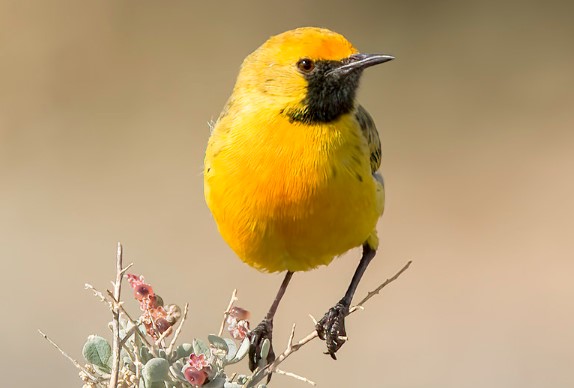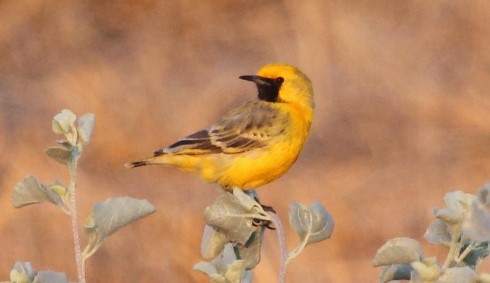Family: An Orange chat (Epthianura aurifrons) belongs to the Meliphagidae family of birds. The species is endemic to Australia.
Habitats: Brilliant orange chats live in arid zones where they are nomadic and gregarious. Because of this, they sometimes feed in mixed parties when not breeding, just like the Crimson Chat. However, there are differences between them. Salt-bush, blue-bush (chenopod) steppes, and samphire around dry salt lakes are common habitats for oranges, which rarely gather in flocks larger than 50 birds.
Diet: Foraging exclusively on insects, orange chats run rapidly along the ground. The orange chat mainly feeds on invertebrates, small insects (ants, bees, wasps, caterpillars, grasshoppers, and beetles), and spiders on the ground and in shrubs. Zebra finches or crimson-fronted chats may occasionally feed with them.

Behavior: Their activity conserves body fluids by lowering their metabolic rate, and they search for fresh drinking water by nomadism; they fly low in low, dipping undulations until they find it. However, they seem to be able to tolerate dry conditions better than crimson chats, staying and breeding at any site for longer periods of time. In late winter, the flocks break up into territorial pairs as breeding season approaches. For the event, males gain brilliant nuptial plumage and establish territories, while females construct nests. Males click their bills and squeak without making contact with intruders, flying low over bushes to chase them off. His head is jerkily turned in all directions while the tail is spread to reveal his orange rump while he perches on top of a tall bush.
The males show their orange and black faces and back to all opponents before giving chase as soon as an intrusion is detected as little as 30 meters away from the nest. Males attend to their mates closely until they lay eggs, and then they share in the incubation process. At the slightest provocation, stressed males slip away to chase away intruders and forage well away from their territories. When a nest is threatened, both parents feign injury by dropping to the ground and feeding the nestlings. The young stay in the territory for the first few days after fledging, where they crouch motionless under bushes, protected by adult birds who pretend to be injured. Parents feed their young for a few days, then the whole family moves to join local flocks.
Similar Species: There are two bird species that are similar to and often confused with orange chats. There are yellow chats and crimson chats. However, the bill of orange chats tends to be straighter and shorter on average.

Alternative Names: It is also known as Orange-fronted Chat, Orange-fronted Nun, Tang, Orange-breasted Chat, Golden-fronted, Bush Chat, and Saltbush Canary.
Movement: Food availability in an area is affected by weather conditions, which determine movement patterns. Orange chats can be absent from their usual habitats during droughts or dry spells and can sometimes be seen on the periphery of their usual range.
Size and Weight: Approximately 105–120 mm in length, 10–12 grams in weight, and 19 cm (7.5 in) in wingspan, Orange Chats weigh about 10–12 grams.
Identification: As far as identification, the male’s head, side of the face, lower back, rump, and all underparts are yellow. The forehead, center of the breast, and belly are tinged orange. Lores and throat are black. Olive-yellow with black streaks on the back and shoulders. Its wings and tail are dusky, and its feathers are tipped white and edged with white. The eyes are brick-red to orange-brown in color. There is black on the bill and the legs. There are no seasonal differences in the plumage of orange chats. ECLIPSE MALE: It is the same as a nuptial male, but paler, purer yellow; the black bib has been reduced. Female: Generally greenish-gray-brown on upper parts, with dusky streaks on the crown and mantle; pale yellow on the rump. On the breast, there is a grey-brown wash on the underparts. IMMATURES: Females in their first year.
Voice Call and Song: An orange chat is a small ground songbird with a metallic tang call and a mellow cheek-cheek flight call. Calls do not play a significant role in territorial activity, even when males squeak at intruders when they click their bills. Males shu-shu-shu when calling females. When both sexes feign injury, they use a louder shu-shu-shu call. Parents can also call their children Shu-shu-shu by giving them food.
Displays that distract: One or both adults engage in distraction displays during incubation and after fledging, including flapping along the ground while feigning injury. They sometimes do not return to their nests when observers or predators are present.
Nesting and Breeding: The breeding and nesting season is between July and April, but mostly between August and December. In saltbush or cottonbush up to 25 cm from the ground, nests are made of dry grass and fine twigs, lined with fine rootlets, flower heads, and hair.
Eggs and Incubation: The bird typically lays three, sometimes four eggs; they are white, sometimes with a faint pink tint, with scattered red-black, sepia, and red-brown spots; they are oval in shape, about 18 x 13 mm. Both sexes go through an incubation period of 12 to 14 days. It takes about ten to twelve days for the young to fledge.
Invaders: Both parents will call loudly if a predator approaches and fake an injury to distract the creature from the nest. There are both introduced and native predators: cats, snakes, foxes, and large birds, such as ravens and crows.
Distribution: The orange chat occurs mainly in saltbush plains, samphire around salt lakes, shrub-dotted gibber plains in arid Australia, and coastal marshes in South and Western Australia. A number of arid and semi-arid regions throughout Australia are home to orange chats, who reside in dry, low-lying, saline habitats that are rarely flooded, including gibber plains, saltpans, salt lakes, and claypans with sparse vegetation.
Races: Nomadic, but no races.
